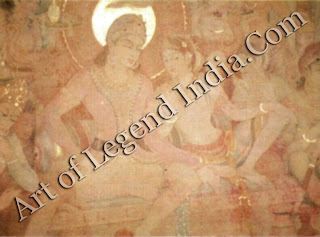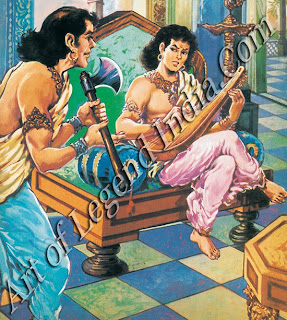Gupta Fourth to Sixth Century A.D.
The
Gupta emperors were great patrons of art and literature. The aesthetic
qualities of Samudragupta are very well known. His proficiency in music is
narrated in the Allahabad prasasti in the highest terms and equally so his
poetic skill. The lyrist type of coin confirms the statement in the
inscription. His son, Chandragupta II, has a wonderful coin showing him seated
on a couch with a lotus in his hand, the lilakamala, suggesting what a great
connoisseur he was of everything aesthetic. This suggestive coin has an
appropriate legend, rupakriti. He was a 'Prince Charming' with an aesthetic
temperament. Another Gupta coin, representing the king seated on a couch with
Lakshmi and Sarasvati flanking him, shows that he was the abode of learning and
prosperity. It is this which has been usually called the golden age of art in
India. The coinage of the period is probably the most artistic produced in
India, and it is to be expected that where sculpture of the highest order
flourished, there should have been equally great painting.
This
phase of art of the Gupta period is amply illustrated in the caves, close to
the village Bagh in the former Gwalior State, which are excavated on the slopes
of the Vindhya Hills at a height of 150 ft above the river Bagh in the vicinity.
There are nine caves in all but the most important are Caves 2, 4 and 5. These
caves were almost rediscovered in 1818 by Lieutenant Dangerfield, but it is
Col. C.E. Luard who created that interest in the study of these caves that
accounts for their being known so well today. Since excellent copies were
prepared of them by Nandalal Bose and Asit Kumar Haldar and others, they have
very much deteriorated and probably the best are their copies which may be seen
in the Gwalior Museum.
Cave 2
contains excellent sculptural examples of Buddha flanked by two attendant
Bodhisattvas with chauris in their hands. The stupa here is a simple one of the
early type. These are also Bodhisattva figures here carved in the best
traditions of Gupta plastic art. The principal doorway of Cave 4 has river
goddesses on the makara on either side at the top flanking the lintel and are
very typical of early Gupta style.
 The
paintings in the Bagh caves are mostly lost, but the best preserved of the
remains are found on the outer wall of the continuous verandah of Caves 4 and
5. The heavy pillars that once supported the verandah are now lost and the roof
has also collapsed, leaving the paintings exposed to weather. But fortunately
there is enough preserved in spite of the enormous ruination to proclaim to the
world the glory of the painter's art during the age of the Guptas. The subject
illustrated is clearly a jataka or avadana yet to be identified. The first
scene shows a princess and her com-panion, one in great grief and the other
consoling her; the second, two divine and two princely figures seated in
conversation, Sakra among them clearly indicated by his peculiar crown.
The
paintings in the Bagh caves are mostly lost, but the best preserved of the
remains are found on the outer wall of the continuous verandah of Caves 4 and
5. The heavy pillars that once supported the verandah are now lost and the roof
has also collapsed, leaving the paintings exposed to weather. But fortunately
there is enough preserved in spite of the enormous ruination to proclaim to the
world the glory of the painter's art during the age of the Guptas. The subject
illustrated is clearly a jataka or avadana yet to be identified. The first
scene shows a princess and her com-panion, one in great grief and the other
consoling her; the second, two divine and two princely figures seated in
conversation, Sakra among them clearly indicated by his peculiar crown.
The
third scene shows some monks and probably some lay female devotees, the former
performing the miracle of flying in the air, the latter who appear to be
musicians playing musical instruments as may be seen from a portion of the
lute, vina, that is preserved. Beyond this, the fourth scene presents a
mirthful hallisalasya, a folk-dance with the dancers in ring, keeping time with
little wooden sticks. Two in the group of damsels play the hand-drum or
hudukka, and the third plays the small-sized cymbals or kamsyatalas. The
coiffure and colourful dress of these damsels and particularly of the two
dancers wearing long-sleeved shirts with flowers worked on them are most
interesting for a study of the life and culture of the age. The scene beyond
this shows a procession of people on horse-back and on elephants. The elephants
are magnificent representations of their class and can rank with any of the
very best at Ajanta.
Composed
of cavaliers and foot-soldiers with bows and arrows in their hands and, with
the umbrella held over at least two stately figures, with princes on tuskers
and high-ranking women on cow-elephants close to the royal gateway, probably in
the vicinity of the palace, it suggests an important event in the royal
household and the procession associated with that. It is one of the most
magnificent representations of royal procession in all its glory. On other
walls and on the ceiling in this cave, there are floral deco-rations most
pleasing to the eye, the long meandering length of the lotus-stalk with a
wealth of flowers, half-blown and in full bloom, and pairs of birds in a bight,
particularly geese.
Writer – C.Sivaramamurti
 The
paintings in the Bagh caves are mostly lost, but the best preserved of the
remains are found on the outer wall of the continuous verandah of Caves 4 and
5. The heavy pillars that once supported the verandah are now lost and the roof
has also collapsed, leaving the paintings exposed to weather. But fortunately
there is enough preserved in spite of the enormous ruination to proclaim to the
world the glory of the painter's art during the age of the Guptas. The subject
illustrated is clearly a jataka or avadana yet to be identified. The first
scene shows a princess and her com-panion, one in great grief and the other
consoling her; the second, two divine and two princely figures seated in
conversation, Sakra among them clearly indicated by his peculiar crown.
The
paintings in the Bagh caves are mostly lost, but the best preserved of the
remains are found on the outer wall of the continuous verandah of Caves 4 and
5. The heavy pillars that once supported the verandah are now lost and the roof
has also collapsed, leaving the paintings exposed to weather. But fortunately
there is enough preserved in spite of the enormous ruination to proclaim to the
world the glory of the painter's art during the age of the Guptas. The subject
illustrated is clearly a jataka or avadana yet to be identified. The first
scene shows a princess and her com-panion, one in great grief and the other
consoling her; the second, two divine and two princely figures seated in
conversation, Sakra among them clearly indicated by his peculiar crown. 











0 Response to "The Fourth Gupta Emperors - Samudragupta "
Post a Comment